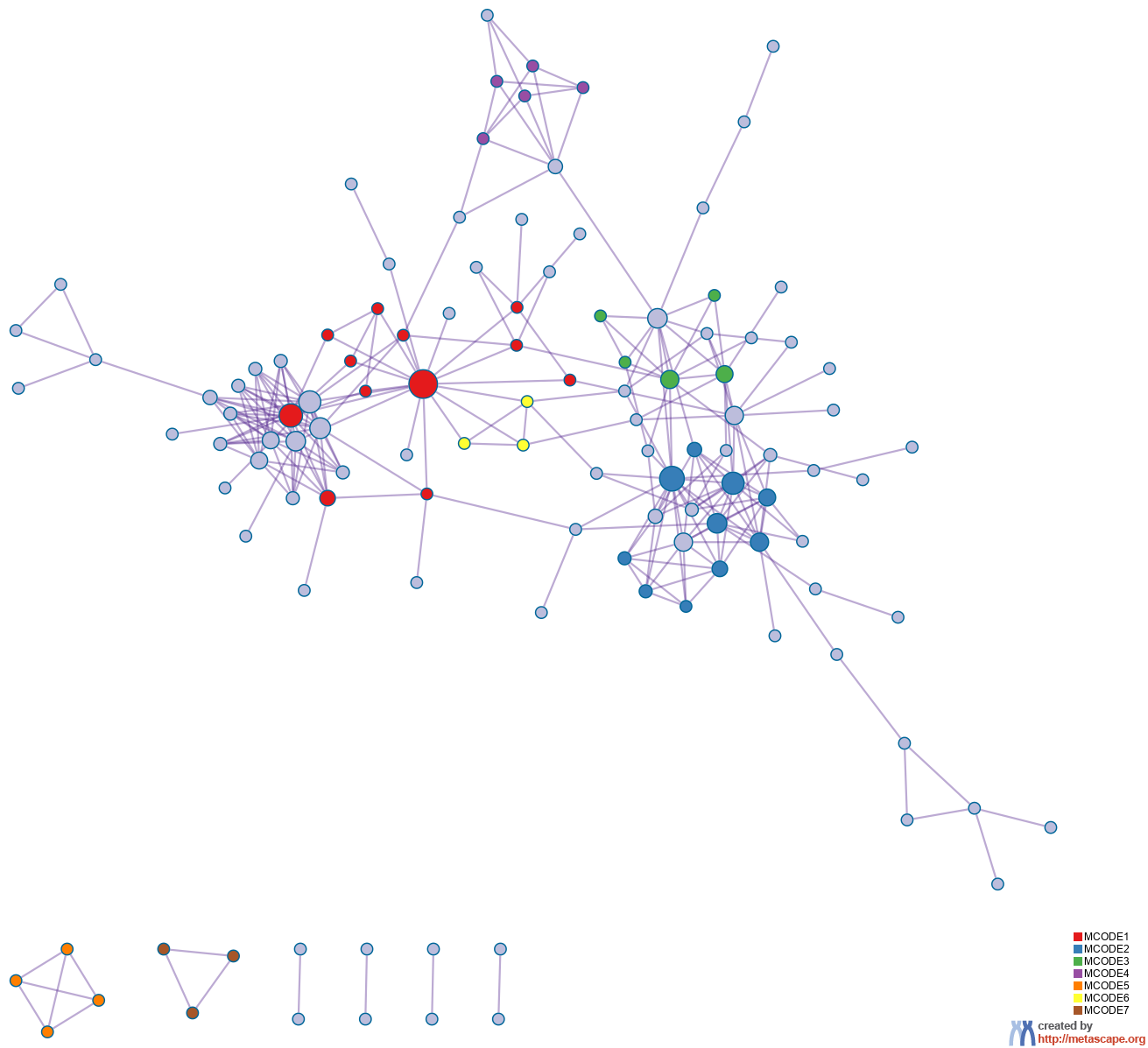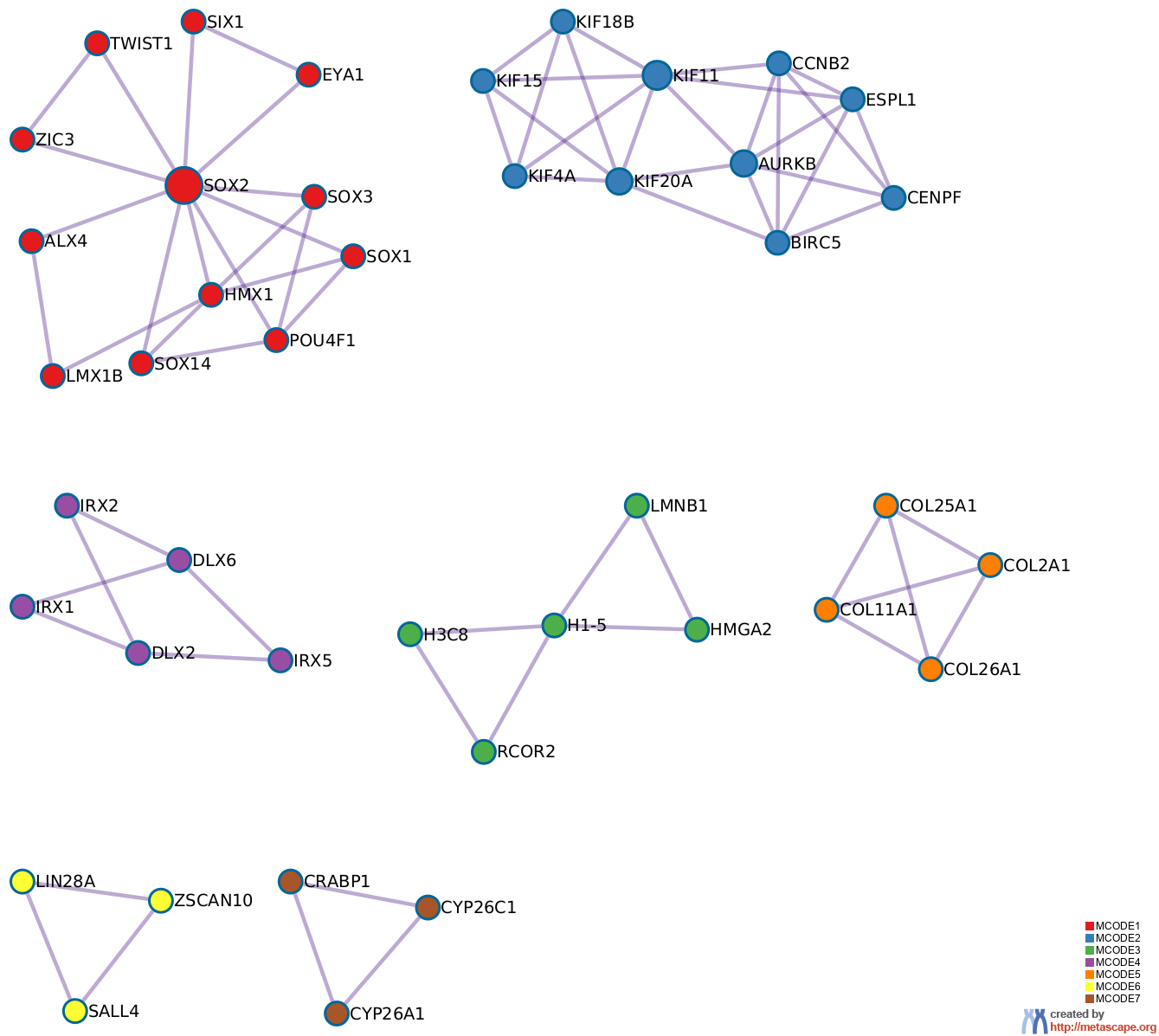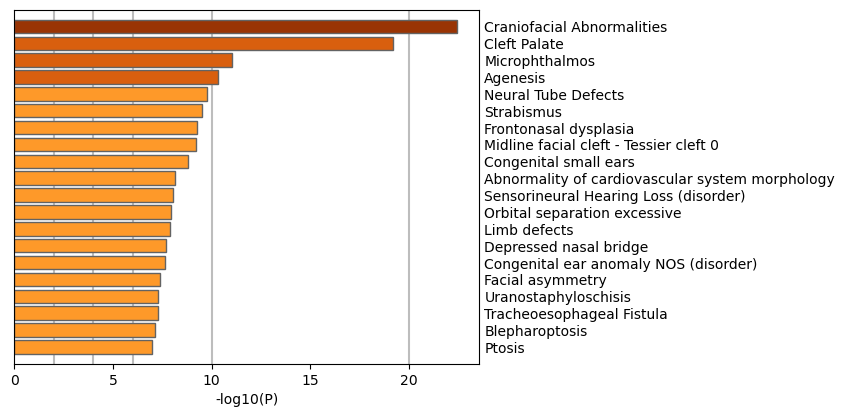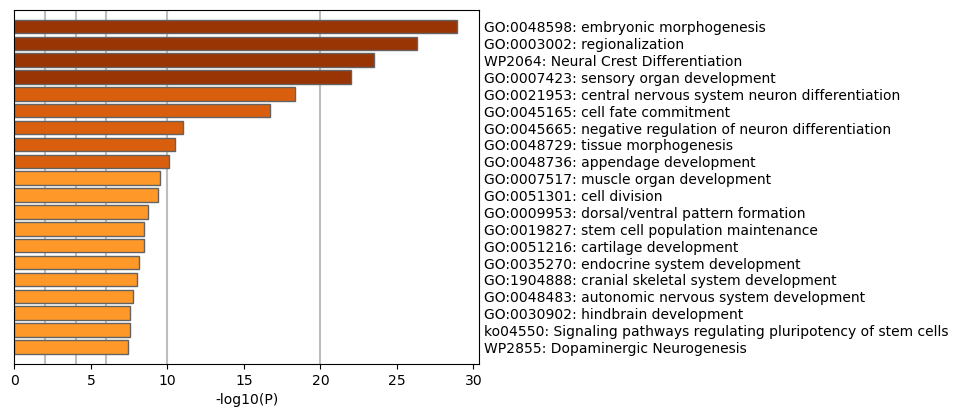Metascape Gene List Analysis Report
metascape.org1
Bar Graph Summary
Gene Lists
User-provided gene identifiers are first converted into their corresponding H. sapiens Entrez gene IDs using the latest version of the database (last updated on 2021-05-01). If multiple identifiers correspond to the same Entrez gene ID, they will be considered as a single Entrez gene ID in downstream analyses. The gene lists are summarized in Table 1.
Table 1. Statistics of input gene lists.
| Name |
Total |
Unique |
| MyList |
238 |
187 |
Gene Annotation
The following are the list of annotations retrieved from the latest version of the database (last updated on 2021-05-01) (Table 2).
Table 2. Gene annotations extracted
| Name |
Type |
Description |
| Gene Symbol |
Description |
Primary HUGO gene symbol. |
| Description |
Description |
Short description. |
| Biological Process (GO) |
Function/Location |
Descriptions summarized based on gene ontology database, where up to three most informative GO terms are kept. |
| Kinase Class (UniProt) |
Function/Location |
Detailed kinase classes. |
| Protein Function (Protein Atlas) |
Function/Location |
Protein Function (Protein Atlas) |
| Subcellular Location (Protein Atlas) |
Function/Location |
Sucellular Location (Protein Atlas) |
| Drug (DrugBank) |
Genotype/Phenotype/Disease |
Drug information for the given gene as target. |
| Canonical Pathways
|
Ontology |
Canonical Pathways
|
| Hallmark Gene Sets
|
Ontology |
Hallmark Gene Sets
|
Pathway and Process Enrichment Analysis
For each given gene list, pathway and process enrichment analysis has been carried out with the following ontology sources: KEGG Pathway, GO Biological Processes, Reactome Gene Sets, Canonical Pathways, CORUM, TRRUST, DisGeNET, PaGenBase, Transcription Factor Targets, WikiPathways, PANTHER Pathway and COVID. All genes in the genome have been used as the enrichment background. Terms with a p-value < 0.01, a minimum count of 3, and an enrichment factor > 1.5 (the enrichment factor is the ratio between the observed counts and the counts expected by chance) are collected and grouped into clusters based on their membership similarities. More specifically, p-values are calculated based on the accumulative hypergeometric distribution
2, and q-values are calculated using the Banjamini-Hochberg procedure to account for multiple testings
3. Kappa scores
4 are used as the similarity metric when performing hierachical clustering on the enriched terms, and sub-trees with a similarity of > 0.3 are considered a cluster. The most statistically significant term within a cluster is chosen to represent the cluster.
Table 3. Top 20 clusters with their representative enriched terms (one per cluster). "Count" is the number of genes in the user-provided lists with membership in the given ontology term. "%" is the percentage of all of the user-provided genes that are found in the given ontology term (only input genes with at least one ontology term annotation are included in the calculation). "Log10(P)" is the p-value in log base 10. "Log10(q)" is the multi-test adjusted p-value in log base 10.
| GO |
Category |
Description |
Count |
% |
Log10(P) |
Log10(q) |
| GO:0048598 |
GO Biological Processes |
embryonic morphogenesis |
40 |
21.86 |
-28.95 |
-24.59 |
| GO:0003002 |
GO Biological Processes |
regionalization |
31 |
16.94 |
-26.29 |
-22.23 |
| WP2064 |
WikiPathways |
Neural Crest Differentiation |
20 |
10.93 |
-23.49 |
-19.60 |
| GO:0007423 |
GO Biological Processes |
sensory organ development |
33 |
18.03 |
-22.01 |
-18.35 |
| GO:0021953 |
GO Biological Processes |
central nervous system neuron differentiation |
20 |
10.93 |
-18.35 |
-14.77 |
| GO:0045165 |
GO Biological Processes |
cell fate commitment |
21 |
11.48 |
-16.69 |
-13.37 |
| GO:0045665 |
GO Biological Processes |
negative regulation of neuron differentiation |
10 |
5.46 |
-11.00 |
-8.11 |
| GO:0048729 |
GO Biological Processes |
tissue morphogenesis |
23 |
12.57 |
-10.47 |
-7.62 |
| GO:0048736 |
GO Biological Processes |
appendage development |
13 |
7.10 |
-10.11 |
-7.28 |
| GO:0007517 |
GO Biological Processes |
muscle organ development |
16 |
8.74 |
-9.49 |
-6.72 |
| GO:0051301 |
GO Biological Processes |
cell division |
21 |
11.48 |
-9.36 |
-6.60 |
| GO:0009953 |
GO Biological Processes |
dorsal/ventral pattern formation |
9 |
4.92 |
-8.73 |
-6.01 |
| GO:0019827 |
GO Biological Processes |
stem cell population maintenance |
11 |
6.01 |
-8.48 |
-5.80 |
| GO:0051216 |
GO Biological Processes |
cartilage development |
12 |
6.56 |
-8.46 |
-5.79 |
| GO:0035270 |
GO Biological Processes |
endocrine system development |
10 |
5.46 |
-8.11 |
-5.47 |
| GO:1904888 |
GO Biological Processes |
cranial skeletal system development |
8 |
4.37 |
-8.00 |
-5.38 |
| GO:0048483 |
GO Biological Processes |
autonomic nervous system development |
7 |
3.83 |
-7.72 |
-5.14 |
| GO:0030902 |
GO Biological Processes |
hindbrain development |
10 |
5.46 |
-7.57 |
-5.01 |
| ko04550 |
KEGG Pathway |
Signaling pathways regulating pluripotency of stem cells |
10 |
5.46 |
-7.57 |
-5.01 |
| WP2855 |
WikiPathways |
Dopaminergic Neurogenesis |
6 |
3.28 |
-7.44 |
-4.91 |
To further capture the relationships between the terms, a subset of enriched terms have been selected and rendered as a network plot, where terms with a similarity > 0.3 are connected by edges. We select the terms with the best p-values from each of the 20 clusters, with the constraint that there are no more than 15 terms per cluster and no more than 250 terms in total. The network is visualized using
Cytoscape5, where each node represents an enriched term and is colored first by its cluster ID (Figure 2.a) and then by its p-value (Figure 2.b). These networks can be interactively viewed in Cytoscape through the .cys files (contained in the Zip package, which also contains a publication-quality version as a PDF) or within a browser by clicking on the web icon. For clarity, term labels are only shown for one term per cluster, so it is recommended to use Cytoscape or a browser to visualize the network in order to inspect all node labels. We can also export the network into a PDF file within Cytoscape, and then edit the labels using Adobe Illustrator for publication purposes. To switch off all labels, delete the "Label" mapping under the "Style" tab within Cytoscape, and then export the network view.
Figure 2. Network of enriched terms: (a) colored by cluster ID, where nodes that share the same cluster ID are typically close to each other; (b) colored by p-value, where terms containing more genes tend to have a more significant p-value.
Protein-protein Interaction Enrichment Analysis
For each given gene list, protein-protein interaction enrichment analysis has been carried out with the following databases: STRING
6, BioGrid
7, OmniPath
8, InWeb_IM
9.Only physical interactions in STRING (physical score > 0.132) and BioGrid are used (
details). The resultant network contains the subset of proteins that form physical interactions with at least one other member in the list. If the network contains between 3 and 500 proteins, the Molecular Complex Detection (MCODE) algorithm
10 has been applied to identify densely connected network components. The MCODE networks identified for individual gene lists have been gathered and are shown in Figure 3.
Pathway and process enrichment analysis has been applied to each MCODE component independently, and the three best-scoring terms by p-value have been retained as the functional description of the corresponding components, shown in the tables underneath corresponding network plots within Figure 3.
Figure 3. Protein-protein interaction network and MCODE components identified in the gene lists.
 | |  |



| |



|
| GO |
Description |
Log10(P) |
| GO:0048598 |
embryonic morphogenesis |
-26.4 |
| WP2064 |
Neural Crest Differentiation |
-22.1 |
| GO:0007423 |
sensory organ development |
-19.8 |
| |
| Color |
MCODE |
GO |
Description |
Log10(P) |
|
MCODE_1 |
GO:0007423 |
sensory organ development |
-7.4 |
|
MCODE_1 |
GO:0001708 |
cell fate specification |
-7.4 |
|
MCODE_1 |
GO:0048598 |
embryonic morphogenesis |
-7.3 |
|
MCODE_2 |
GO:0051301 |
cell division |
-14.1 |
|
MCODE_2 |
GO:0140014 |
mitotic nuclear division |
-11.8 |
|
MCODE_2 |
R-HSA-983189 |
Kinesins |
-11.1 |
|
MCODE_3 |
R-HSA-2559584 |
Formation of Senescence-Associated Heterochromatin Foci (SAHF) |
-8.8 |
|
MCODE_3 |
R-HSA-2559583 |
Cellular Senescence |
-7.9 |
|
MCODE_3 |
R-HSA-2559586 |
DNA Damage/Telomere Stress Induced Senescence |
-6.7 |
|
MCODE_4 |
GO:0048598 |
embryonic morphogenesis |
-8.5 |
|
MCODE_4 |
GO:0009954 |
proximal/distal pattern formation |
-7.9 |
|
MCODE_4 |
GO:0048562 |
embryonic organ morphogenesis |
-5.0 |
|
MCODE_5 |
R-HSA-8948216 |
Collagen chain trimerization |
-11.3 |
|
MCODE_5 |
M3005 |
NABA COLLAGENS |
-11.3 |
|
MCODE_5 |
R-HSA-1442490 |
Collagen degradation |
-10.6 |
|
MCODE_6 |
R-HSA-452723 |
Transcriptional regulation of pluripotent stem cells |
-9.3 |
|
MCODE_6 |
GO:0035019 |
somatic stem cell population maintenance |
-7.8 |
|
MCODE_6 |
GO:0019827 |
stem cell population maintenance |
-6.9 |
|
MCODE_7 |
GO:0034653 |
retinoic acid catabolic process |
-11.6 |
|
MCODE_7 |
GO:0016103 |
diterpenoid catabolic process |
-11.6 |
|
MCODE_7 |
GO:0016115 |
terpenoid catabolic process |
-11.0 |
|
Quality Control and Association Analysis
Gene list enrichments are identified in the following ontology categories: Transcription_Factor_Targets, TRRUST, DisGeNET, PaGenBase, COVID. All genes in the genome have been used as the enrichment background. Terms with a p-value < 0.01, a minimum count of 3, and an enrichment factor > 1.5 (the enrichment factor is the ratio between the observed counts and the counts expected by chance) are collected and grouped into clusters based on their membership similarities. The top few enriched clusters (one term per cluster) are shown in the Figure 4-8. The algorithm used here is the same as that is used for pathway and process enrichment analysis.
Figure 4. Summary of enrichment analysis in Transcription_Factor_Targets11.

|

|
| GO |
Description |
Count |
% |
Log10(P) |
Log10(q) |
| M30019 |
HSD17B8 TARGET GENES |
40 |
22.00 |
-27.00 |
-22.00 |
| M8172 |
HNF6 Q6 |
17 |
9.30 |
-12.00 |
-8.50 |
| M4815 |
WTTGKCTG UNKNOWN |
19 |
10.00 |
-8.80 |
-5.40 |
| M18169 |
YATGNWAAT OCT C |
16 |
8.70 |
-8.60 |
-5.20 |
| M6325 |
SMAD3 Q6 |
13 |
7.10 |
-8.10 |
-4.80 |
| M946 |
GGATTA PITX2 Q2 |
19 |
10.00 |
-7.90 |
-4.70 |
| M6490 |
IPF1 Q4 |
13 |
7.10 |
-7.80 |
-4.60 |
| M11587 |
CHX10 01 |
12 |
6.60 |
-7.40 |
-4.30 |
| M3902 |
POU1F1 Q6 |
12 |
6.60 |
-7.20 |
-4.10 |
| M5708 |
OCT1 05 |
12 |
6.60 |
-6.90 |
-3.90 |
| M1328 |
WTGAAAT UNKNOWN |
18 |
9.80 |
-6.80 |
-3.90 |
| M4225 |
NFY 01 |
12 |
6.60 |
-6.80 |
-3.90 |
| M9868 |
NFY Q6 |
12 |
6.60 |
-6.80 |
-3.80 |
| M14960 |
POU3F2 02 |
12 |
6.60 |
-6.70 |
-3.80 |
| M19088 |
TST1 01 |
12 |
6.60 |
-6.70 |
-3.80 |
| M15623 |
SOX5 01 |
12 |
6.60 |
-6.70 |
-3.80 |
| M4764 |
TGTTTGY HNF3 Q6 |
19 |
10.00 |
-6.30 |
-3.50 |
| M16345 |
NKX3A 01 |
11 |
6.00 |
-6.30 |
-3.50 |
| M6135 |
POU6F1 01 |
11 |
6.00 |
-6.30 |
-3.50 |
| M1224 |
TCF4 Q5 |
11 |
6.00 |
-6.20 |
-3.40 |
|
Figure 5. Summary of enrichment analysis in TRRUST.

|

|
| GO |
Description |
Count |
% |
Log10(P) |
Log10(q) |
| TRR00230 |
Regulated by: E2F1 |
6 |
3.30 |
-3.50 |
-1.40 |
| TRR00233 |
Regulated by: E2F4 |
3 |
1.60 |
-3.30 |
-1.20 |
| TRR01419 |
Regulated by: TP53 |
6 |
3.30 |
-3.00 |
-1.00 |
| TRR01259 |
Regulated by: SP3 |
5 |
2.70 |
-2.80 |
-0.92 |
| TRR01277 |
Regulated by: STAT3 |
5 |
2.70 |
-2.40 |
-0.57 |
| TRR00270 |
Regulated by: EP300 |
3 |
1.60 |
-2.10 |
-0.38 |
|
Figure 6. Summary of enrichment analysis in DisGeNET12.

|

|
| GO |
Description |
Count |
% |
Log10(P) |
Log10(q) |
| C0376634 |
Craniofacial Abnormalities |
25 |
14.00 |
-22.00 |
-18.00 |
| C0008925 |
Cleft Palate |
32 |
17.00 |
-19.00 |
-15.00 |
| C0026010 |
Microphthalmos |
18 |
9.80 |
-11.00 |
-7.30 |
| C0000846 |
Agenesis |
13 |
7.10 |
-10.00 |
-6.60 |
| C0027794 |
Neural Tube Defects |
16 |
8.70 |
-9.80 |
-6.20 |
| C0038379 |
Strabismus |
23 |
13.00 |
-9.50 |
-5.90 |
| C1876203 |
Frontonasal dysplasia |
6 |
3.30 |
-9.30 |
-5.80 |
| C0432106 |
Midline facial cleft - Tessier cleft 0 |
5 |
2.70 |
-9.20 |
-5.80 |
| C0152423 |
Congenital small ears |
11 |
6.00 |
-8.80 |
-5.40 |
| C4049796 |
Abnormality of cardiovascular system morphology |
12 |
6.60 |
-8.10 |
-4.80 |
| C0018784 |
Sensorineural Hearing Loss (disorder) |
22 |
12.00 |
-8.00 |
-4.80 |
| C0020534 |
Orbital separation excessive |
19 |
10.00 |
-7.90 |
-4.70 |
| C0740404 |
Limb defects |
8 |
4.40 |
-7.90 |
-4.70 |
| C1836542 |
Depressed nasal bridge |
16 |
8.70 |
-7.70 |
-4.50 |
| C0266589 |
Congenital ear anomaly NOS (disorder) |
10 |
5.50 |
-7.60 |
-4.50 |
| C1306710 |
Facial asymmetry |
9 |
4.90 |
-7.40 |
-4.30 |
| C2981150 |
Uranostaphyloschisis |
11 |
6.00 |
-7.30 |
-4.20 |
| C0040588 |
Tracheoesophageal Fistula |
8 |
4.40 |
-7.30 |
-4.20 |
| C0005745 |
Blepharoptosis |
18 |
9.80 |
-7.10 |
-4.10 |
| C0033377 |
Ptosis |
18 |
9.80 |
-7.00 |
-4.00 |
|
Figure 7. Summary of enrichment analysis in PaGenBase13.

|

|
| GO |
Description |
Count |
% |
Log10(P) |
Log10(q) |
| PGB:00126 |
Cell-specific: Testis cell |
5 |
2.70 |
-6.20 |
-3.40 |
| PGB:00007 |
Tissue-specific: colon |
11 |
6.00 |
-4.80 |
-2.50 |
| PGB:00107 |
Cell-specific: SHSYSY-RA |
4 |
2.20 |
-3.70 |
-1.50 |
| PGB:00060 |
Tissue-specific: retinoblastoma |
5 |
2.70 |
-3.40 |
-1.30 |
| PGB:00101 |
Tissue-specific: Colorectal adenocarcinoma |
3 |
1.60 |
-2.60 |
-0.75 |
| PGB:00019 |
Cell-specific: H1-hesc |
8 |
4.40 |
-2.00 |
-0.30 |
|
Figure 8. Summary of enrichment analysis in COVID14.

|

|
| GO |
Description |
Count |
% |
Log10(P) |
Log10(q) |
| COVID054 |
RNA_Xiong_PBMC_Up |
18 |
9.80 |
-12.00 |
-8.10 |
| COVID007 |
RNA_Blanco-Melo_A549_Down |
13 |
7.10 |
-7.00 |
-4.00 |
| COVID015 |
RNA_Blanco-Melo_Calu-3_Down |
11 |
6.00 |
-5.30 |
-2.80 |
| COVID134 |
Proteome_Stukalov_A549-ACE2_24h_Down |
10 |
5.50 |
-4.60 |
-2.20 |
| COVID147 |
Proteome_Stukalov_A549_72h_NSP13_Up |
6 |
3.30 |
-3.90 |
-1.70 |
| COVID071 |
Proteome_Bouhaddou_Vero_E6_24h_Down |
5 |
2.70 |
-3.40 |
-1.30 |
| COVID315 |
RNA_Wilk_CD8+T-cells_patient-C6_Up |
3 |
1.60 |
-2.60 |
-0.75 |
| COVID313 |
RNA_Wilk_CD8+T-cells_patient-C5_Up |
3 |
1.60 |
-2.60 |
-0.70 |
| COVID049 |
RNA_Wyler_Calu-3_24h_Down |
7 |
3.80 |
-2.40 |
-0.61 |
| COVID347 |
RNA_Wilk_B-cells_patient-C6_Up |
4 |
2.20 |
-2.20 |
-0.45 |
| COVID185 |
Proteome_Stukalov_A549_72h_S_Up |
3 |
1.60 |
-2.10 |
-0.35 |
|
Reference
- Zhou et al., Metascape provides a biologist-oriented resource for the analysis of systems-level datasets. Nature Communications (2019) 10(1):1523.
- Zar, J.H. Biostatistical Analysis 1999 4th edn., NJ Prentice Hall, pp. 523
- Hochberg Y., Benjamini Y. More powerful procedures for multiple significance testing. Statistics in Medicine (1990) 9:811-818.
- Cohen, J. A coefficient of agreement for nominal scales. Educ. Psychol. Meas. (1960) 20:27-46.
- Shannon P. et al., Cytoscape: a software environment for integrated models of biomolecular interaction networks. Genome Res (2003) 11:2498-2504.
- Szklarczyk D. et al. STRING v11: protein-protein association networks with increased coverage, supporting functional discovery in genome-wide experimental datasets. Nucleic Acids Res. (2019) 47:D607-613.
- Stark C. et al. BioGRID: a general repository for interaction datasets. Nucleic Acids Res. (2006) 34:D535-539.
- Turei D. et al. A scored human protein-protein interaction network to catalyze genomic interpretation. Nat. Methods. (2016) 13:966-967.
- Li T. et al. A scored human protein-protein interaction network to catalyze genomic interpretation. Nat. Methods. (2017) 14:61-64.
- Bader, G.D. et al. An automated method for finding molecular complexes in large protein interaction networks. BMC bioinformatics (2003) 4:2.
- Subramanian A, et al. Gene set enrichment analysis: A knowledge-based approach for interpreting genome-wide expression profiles. Proc Natl Acad Sci U S A 102, 15545-15550 (2005).
- Pinero J, et al. DisGeNET: a comprehensive platform integrating information on human disease-associated genes and variants. Nucleic acids research 45, D833-D839 (2017).
- Pan JB, et al. PaGenBase: a pattern gene database for the global and dynamic understanding of gene function. PLoS One 8, e80747 (2013).
- https://metascape.org/COVID.










